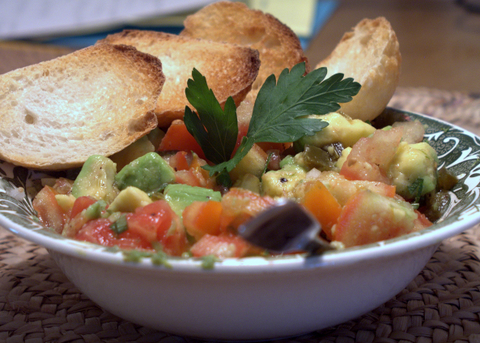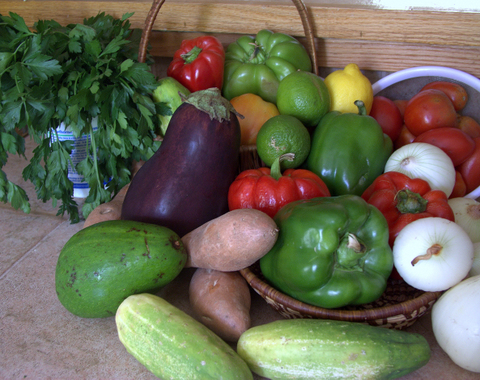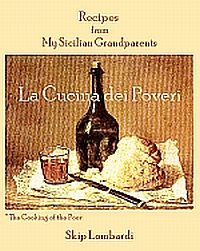Living on $42.00 per Week-Day 2
July 17th, 2007Here is a brief follow-up to our first day’s culinary adventures.
On Sunday afternoon, we went to Whole Foods, where we bought approximately 3 Lbs. of a halibut frame. For those who may not know that term, it’s merely the carcass, left over after the fish has been filleted. Whole Foods will be happy to sell you all or part of a fish frame (also known as a rack) for $1.99 per pound.
Sometimes, a seemingly inedible foodstuff can serve as the catalyst for several meals. In the case of our fish frame, we’ll make at least three and possibly four quarts of fish broth. From there, we can make a Mediterranean fish soup, seafood risotto, or perhaps a seafood couscous. With options like these, $1.99 per pound struck us as a bargain. And when we saw how much meat was left on this fish frame, we had no problem parting with $6.11.
Total food stamp funds remaining: $17.87.
Sunday Supper:
We simply removed our Wal*Mart rotisserie chicken from the fridge and allowed it to come to room temperature. For this meal, we served the leg and thigh quarters along with boiled potatoes and sliced plum tomatoes dressed with olive oil, red wine vinegar, and chopped flat-leaf Italian parsley.
We cut the boiled potatoes into bite-sized pieces and tossed them—skin on—with two minced scallions, a couple of Tbs. each of flat-leaf Italian parsley and spearmint ( we keep ours growing a pot on our porch). A scant Tbs. of olive oil and approximately two Tbs. of citrus vinegar, salt, black pepper and a dash of chili sauce finished the potatoes.
On Tuesday, we’ll very likely finish the chicken, although we’ll still have the remainder of the carcass. Cooked chicken bones may not make a great stock, but they still have a lot of flavor to contribute. We haven’t thought that far ahead, but we’ll surely figure out something to do with them.
###
Monday Lunch:
We put together a salad of avocado and tomatoes that, although the essence of simplicity, was entirely satisfying. Along with some rolls from the day-old shelf at BJ’s —sliced and toasted as crostini—we had a delicious lunch.
Avocado & Tomato Salad

Ingredients:
1/2 Large Florida Avocado, cut into small cubes
1 Med. tomato, coarsely chopped
1 Pickled jalapeno, minced
1/2 tsp. grated lime rind
1/2 tsp. grated fresh ginger
6 fresh mint leaves, finely chopped
3 or 4 grinds from the pepper mill
1/4 – 1/2 tsp. salt
2 – 3 tsp. lime juice (the juice from approximately 1/2 lime)
1 Tbs. onion, finely chopped
Preparation:
Combine the avocado, tomato, jalapeno, lime rind, ginger, and mint leaves in a non-reactive bowl. Stir gently to mix. Add the pepper, taste for salt and add up to 1/2 tsp. as necessary. Add the juice of 1/2 lime and the onion.
Allow to sit at room temperature for approximately 1/2 hour before serving. Serve with toasted baguette, or, as we did, with sliced and toasted day-old rolls from BJ’s.
Serves two.
Monday Supper:
We were able to dissect nearly one pound of usable meat from the fish frame. (Here again, we have a couple of advantages: a very sharp multi-purpose carbon steel knife and the skills to use it.) While the meat we rescued was not pretty and would have been of no value to Whole Foods, it was ideal for our purposes; we marinated it in citrus and olive oil and made a delicious, elegant supper of ceviche.
Again, we served the ceviche with boiled red-skinned potatoes and a salad of Romaine and tomatoes.
Ceviche
Ingredients:
1 Lb. firm-fleshed white fish (again, we used halibut, but you’d do fine with cod or ocean perch)
1 Lemon
1 Red bell pepper, julienned
1 Small white onion, thinly sliced
1/4 Cup Flat-leaf Italian parsley, coarsely chopped
1 Small clove garlic, finely chopped
2 Tbs. Olive oil
Salt & freshly ground black pepper
2 Bay leaves
Lettuce for serving (optional)
Preparation:
Cut the fish into bite-sized chunks and place in a non-reactive bowl. Grate the zest of the lemon over the fish, then cut the lemon in half and squeeze the juice into the bowl. Toss to coat all the fish pieces. This begins the process of “cooking” the fish.
Add all the remaining ingredients and stir well. Cover the bowl and refrigerate for at least one hour ( and up to 24 hrs.) before serving.
Stir again before serving and plate atop coarsely torn Romaine.
Serves four as a starter, two as an main course.
Links to the other posts in our series:
Living on $42.00 Per Week—the Challenge
Living on $42.00 Per Week—Day 1
Living on $42.00 Per Week—Day 3
Living on $42.00 Per Week—Day 4
Living on $42.00 Per Week—Day 5
Living on $42.00 Per Week—Day 6
Living on $42.00 Per Week—Day 7
Living on $42.00 Per Week—Summary
Living on $42.00 Per Week—Redux
Living on $42.00 per Week-Day 1
July 16th, 2007We did indeed shop yesterday at the Red Barn in Bradenton, where we bought what will probably be all the fresh produce we’ll need for the week. We began with a Mexican friend who runs one of the vegetable stalls with her husband and two sons. She has an endearing custom of packaging diverse vegetables into what we call ‘kits.’ And irrespective of the contents, she sells each kit at $1.00.
For example, one Saturday, we found a kit that contained all the necessary vegetables for the Sicilian vegetable stew, caponata. Today, we bought two kits: one with four huge green and red bell peppers, and another with a Florida onion, a dozen plum tomatoes, and four cucumbers.
Seperately, we selected some Florida white onions, 3 lemons, 3 limes, and a large Florida avocado. Total price: $5.40.
At another stall across the way, we found a very large head of Romaine lettuce, and two large bunches of flat-leaf Italian parsley. Total price: $2.50.
The first stall at the entryway to the market yielded two eggplants at 2/$1.00, a 5 Lb. Bag of red-skinned potatoes, and 3 sweet potatoes. Total price: $3.19.

Total for the Red Barn: $11.09.
On our way home, we stopped at Wal*Mart Super Center on State Road 70 to buy coffee (French Roast 100% Arabica. 2 Lb. 2.5 oz. for $5.58). While we were there, we found rotisserie chickens* on sale. The one we selected was approximately 1.5 Lb., came off the rotisserie at 11:35 a.m. and cost $3.98. And while we weren’t “shopping” per se, we also spotted some Barilla pasta in a hard-to-find shape we like, so we picked up a pound at $0.98.
Total for Wal*Mart: 10.80 – 3.98 = $6.82 (We had to pay for the chicken outside our food stamp allowance).
Total so far: $17.81. Total remaining: $24.09.
- Note: under the current guidelines, the chicken would not be eligible for purchase with food stamps. Florida eligibility guidelines exclude take-out and “hot foods.” We consider this unfortunate, because we’ll probably get two meals out of our chicken. And we think that beyond the price, it’s a great way to conserve energy—particularly during this hot weather. For two meals, our energy use for preparation and washing up will be practically nil.
- Note also: Just for fun, we took our Red Barn shopping list to Whole Foods this afternoon. Buying these ingredients at Whole Foods—not all of which were organic—would have cost us $55.48.
But we’re not here to fix a broken world. We’re merely trying to live within the guidelines and to report our experiences.
Sunday Lunch:
Considering the bounty we brought home, it seemed reasonable to use some of it right away rather than store it. And again, we’re also mindful of our fossil fuel consumption in hot weather. A salad seemed a great choice for lunch. We had some motivation to make this Tuscan bread salad, because we had two ciabatta rolls “of a certain age” in the fridge. Sometimes, even a stale ingredient can stimulate an idea for a meal.
Tuscans are particularly frugal when it comes to bread, and have found some creative ways to use leftovers no longer suitable for the table. Most notable among them are, papa al pomodoro, tomato and bread soup, and this salad, panzanella.
Panzanella
Tuscan Bread Salad
Ingredients:
4 slices stale Italian bread (We used two ciabatta rolls)
1 Clove garlic, peeled, and halved
4 tomatoes, cut into 1″ chunks
1 Large Bermuda onion, peeled, and thinly sliced
1 Medium cucumber, peeled, and sliced into 1/4″ rounds
2 – 4 Tbs. Red wine vinegar
4 Tbs. Extra-virgin olive oil
Salt & freshly-ground black pepper
4 Tbs. Flat-leaf Italian parsley, finely chopped
Preparation:
Crumble the bread into rough chunks, and place in a bowl with three or four cups of cold water for about five minutes. While the bread is soaking, rub the inside of a salad bowl with the exposed portions of the garlic. One fistful at a time, squeeze as much water as you can from the bread and add it to the salad bowl.
Break up the bread with a fork, then add the tomatoes, Bermuda onion, cucumber, red wine vinegar, olive oil, and toss to coat all the ingredients. Taste for salt & pepper and add them to your taste.
Add the parsley, divide among four plates, and serve immediately. If you prefer, you can refrigerate the Panzanella for about 1/2 hour before serving. If you plan to do this, though, omit the salt until serving time because the salt will leach moisture from the tomatoes.
Serves four.
Note: This recipe, as written, will indeed serve four very nicely. But for us, it made an abundant lunch for two.
Links to the rest of the posts in our series:
Living on $42.00 Per Week—the Challenge
Living on $42.00 Per Week—Day 1
Living on $42.00 Per Week—Day 3
Living on $42.00 Per Week—Day 4
Living on $42.00 Per Week—Day 5
Living on $42.00 Per Week—Day 6
Living on $42.00 Per Week—Day 7
Living on $42.00 Per Week—Summary
Living on $42.00 Per Week—Redux
Living on $42.00 per Week
July 15th, 2007You may have recently read about a couple of state governors and a congressman or two who have taken up the challenge of living on $21.00 per week for food. That’s the food budget currently available to someone eligible for Federal Food Stamps. We’ve been giving this serious thought and have decided to take up the challenge for ourselves.
For the next week, we’re going to contribute our experiences—what it’s like to live on $21.00 per week. There are two of us, so for this experiment, we’re going to assume that our household is entitled to food stamps and allow ourselves $42.00 for the week.
One of the congressmen, Tim Ryan (D, Ohio), has taken his challenge so far as to eschew lunches at the Capitol—a legitimate perk for all members of Congress. Rep. Ryan’s self-imposed austerity means he will also forgo the comestibles at the fundraisers and cocktail parties that are part of his weekly Washington beat.
We confess we’re less likely to turn down a meal or snack, should we be invited. But we will remember that most people dependent on food stamps do not receive the invitations we get for art gallery openings and wine tastings, where the hors d’oeuvres can be substantial.
We begin this social experiment with an advantage over many food stamp recipients who live with the real threat of hunger and malnutrition. Food is our métier. We’re cooks and we both grew up in families that sat down together for meals virtually every night. We watched our parents and grandparents grow and prepare food. Today, we are self-employed writers who focus on food and culture. We conduct cooking classes, and one of us has worked in a professional kitchen.
The pleasure of food—the buying, preparing, and sharing—is a focal point in our lives. And because we work from home, we try to make time to sit down together for a meal twice per day. We may take breakfast on the run, but lunch and dinner are sacrosanct—times to enjoy conversation as much as the food prepared, however simple the meal may be. And sometimes, it’s very simple—avocado mashed on toast…a hard-boiled egg and tomato salad…
Our everyday meals tend to be what popular media would term “Mediterranean”—in our case, mostly Middle Eastern and Italian. But because we’re both omnivores without food allergies, virtually nothing is off-limits for us. We make frequent forays into Indian, Chinese, and Caribbean cooking as well. And while one of us can inflict serious damage on the dessert bar at an all-you-can eat buffet, neither of us eats a lot of sweets.
Nevertheless, we’ll do our best to stay within the guidelines, and we’ll post our results frequently—at least every other day. Included in our posts, will be recipes for some of what we’ve prepared. We’ll also report any trips for food shopping.
We have a few other advantages over most in real need. As foodies, we begin with a well-stocked larder. For a week’s cooking, we won’t need to buy olive oil, garlic, spices, dried herbs, mustard, vinegar, flour, or many other common pantry items. We already have coffee and tea. Some 1% milk, eggs, and cheese are already in the fridge, and we’ll try to account for those within our $42.00.
Another favorable factor: we own cars. They give us a huge advantage over someone who needs to seek alternative transportation for grocery shopping. As drivers, we can shop at the Red Barn in Bradenton, where a week’s supply of fresh produce can cost less than $10.00. And although it may not be very significant for this short-term challenge, we have a membership at BJ’s. We note it here, because it’s where we bought that 3-litre bottle of Spanish extra-virgin olive oil and the 4 lbs of day-old Ecce Panis ciabatta bread, now in our freezer.
Finally, we have a kitchen—the refrigerator, stove, oven, toaster-oven, and microwave all work. Though we can always pay our bill with FPL, we are frugal with our use of energy.
Links to the rest of the posts in our series:
Living on $42.00 Per Week—Day 1
Living on $42.00 Per Week—Day 2
Living on $42.00 Per Week—Day 3
Living on $42.00 Per Week—Day 4
Living on $42.00 Per Week—Day 5
Living on $42.00 Per Week—Day 6
Living on $42.00 Per Week—Day 7
Living on $42.00 Per Week—Summary
Living on $42.00 Per Week—Redux



